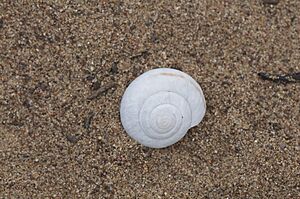Banded dune snail facts for kids
Quick facts for kids Banded dune snail |
|
|---|---|
 |
|
| Conservation status | |
| Scientific classification |
The banded dune snail (also called the Morro shoulderband) is a special type of land snail. Its scientific name is Helminthoglypta walkeriana. It's an endangered animal, meaning it's at risk of disappearing forever. This snail breathes air and is a type of mollusc.
Contents
Meet the Banded Dune Snail
One Snail or Two?
For a while, scientists thought there was only one type of banded dune snail. They called it Helminthoglypta walkeriana. But then they realized there were actually two very similar snails. One was even thought to be extinct, but it was found again!
In 2004, scientists decided to give the second snail its own name: Helminthoglypta morroensis. This snail is now called the Chorro shoulderband. The original Helminthoglypta walkeriana is now known as the Morro shoulderband. Both snails are still considered endangered.
Where Do These Snails Live?
California's Central Coast Home
The Morro shoulderband snail lives only in a small area of California. You can find it near the cities of Morro Bay and Los Osos. These cities are on the central coast in San Luis Obispo County and Santa Barbara County.
The total area where these snails live is very small. It's only about 40 square kilometers (about 15 square miles). That's why they are so special and need protection.
What Do Banded Dune Snails Eat?
Life in the Dunes
These snails are part of the natural food web. They eat decaying plants, which helps to clean up their habitat. However, they also have predators. Birds, reptiles, and even some mammals like to eat these snails.
The Morro shoulderband snails live in coastal sand dunes and scrub areas. They only come out when the weather is wet. If there's a drought, they can seal themselves inside their shells. They might stay hidden for months until the rains return. This helps them survive dry periods.
Protecting the Banded Dune Snail
Why They Need Our Help
Because there are so few of these snails, they are considered endangered. In 1994, the United States officially placed this snail on its Endangered Species List.
Different groups also keep track of how endangered animals are. The IUCN Red List says the Morro shoulderband is Critically Endangered. This means it faces a very high risk of disappearing in the wild. Another group, NatureServe, also considers it Imperiled.
The U.S. Fish and Wildlife Service (USFWS) works to protect these animals. They have suggested that the Morro shoulderband's status might be changed to "threatened" instead of "endangered." They also suggested that the Chorro shoulderband might not need as much protection anymore. This would mean their populations are doing a bit better.



